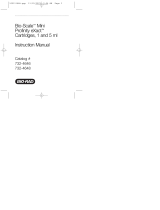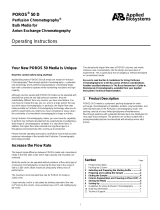Page is loading ...

Sepapure ion exchange (IEX) columns
Short guide
Document Number: V6700
Document no. V6015

Sepapure FPLC column short guide, V6015
Note: For your own safety, read the instructions and observe the
warnings and safety information on the device and in the instructions.
Keep the instructions for future reference.
Phone: +49 30 809727-111 (9-17h, Central European Time)
Fax: +49 30 8015010
E-Mail: support@knauer.net
Languages: German, English
KNAUER Wissenschaftliche Geräte GmbH
Hegauer Weg 38
14163 Berlin
Germany
Phone: +49 30 809727-0
Fax: +49 30 8015010
Internet: www.knauer.net
E-Mail: info@knauer.net
Article number: V6015
Version number: 1.0
Last update: 2019/04/05
This document contains confidential information and may not be
reproduced without written content of KNAUER Wissenschaftliche
Geräte GmbH.
© KNAUER Wissenschaftliche Geräte GmbH 2019
All rights reserved.
AZURA® is a registered trademark of
KNAUER Wissenschaftliche Geräte GmbH.
KNAUER Technical
Support:
Publisher:
Version information:
The information in this document is subject
to change without prior notice.
For latest version of the instructions, check our website:
www.knauer.net/en/Support/User-manuals.
Legal information

Sepapure FPLC columns short guide, V6015
Table of Contents
Table of Contents
1. Specifications ........................................................................1
1.1 Hardware specifications ....................................................1
1.2 Resin specifications ........................................................1
1.3 Buers ...................................................................2
2. Preparing the column .................................................................2
3. Sample preparation ..................................................................2
4. Protein purification ...................................................................3
5. Column regeneration .................................................................3
6. Sanitization .........................................................................3
7. Column storage ......................................................................4
8. Sepapure IEX FF buer compatibility ...................................................4

Sepapure FPLC columns short guide, V6015
1
1. Specifications
Sepapure ion exchange (IEX) columns are designed for purification and
separation of biomolecules based on charge.
The columns are designed to be used with low-pressure FPLC-type auto-
mated purification systems and operated below 3 bar (0.3 MPa, 2.96 atm).
1.1 Hardware specifications
Column housing Polypropylene
Frits Polyethylene (nominal 20 µm porosity)
Fittings 10/32 UNF
Bed volume 1 and 5 ml
1.2 Resin specifications
Resin name Sepapure Q FF Sepapure DEAE FF Sepapure SP FF Sepapure CM FF
Functional Group Quaternary
amine Diethylaminoethyl Sulphonyl
propyl Carboxymethyl
Base matrix material 6% cross-linked, beaded agarose
Mean bead diameter 100 µm
Counter ion binding
capacity (H+/Cl-) 8 – 16 mmol/ml
Recommended flow
rate for a 1 ml column 0.5-2 mL/min (60-240 cm/h)
Recommended flow
rate for a 5 ml column 2-10 mL/min (57-286 cm/h)
pH stability 3 – 12 (long term)
2 – 14 (short term)
Note: Before use, inspect the column for damage. If any damage is
observed, do not use the column.
Note: Flow rates shown in this manual are for guidance only. Always
ensure that system pressure is below the maximum for the column and
resin.

Sepapure FPLC column short guide, V6015
2
1.3 Buers
Sepapure columns are designed to be used with most aqueous phase
chromatography buers. A suggested buer system is shown below, alt-
hough other buers may be used.
Equilibration buer 20 mM Tris, pH 7.4; or
20 mM sodium phosphate, pH 6.8
Wash buer 20 mM Tris, pH 7.4; or
20 mM sodium phosphate, pH 6.8
Elution buer
20 mM Tris with 0.5 M NaCl, pH 7.4; or
20 mM sodium phosphate with 0.5M NaCl,
pH 6.8
For proteins where the optimal purification conditions have not yet
been established, then the following procedure can be used:
Strong anion exchange: Start at pH 8.0 and using a gradient elution
using 1 M NaCl.
Strong cation exchange: Start at pH 6.0 and using a gradient elution
using 1 M NaCl.
In both cases the gradient should run 0-100% .
If the results of the above are not satisfactory, then try weak ion exchange
resins instead (DEAE and CM ligands).
2. Preparing the column
Sepapure ion exchange (IEX) columns are supplied with 20% ethanol as
the storage buer. This must be removed prior to purification.
1. Remove the end-plugs and connect the column to the control system,
taking care to avoid introduction of air into the system.
Note: Do not over-tighten fittings as this can strip the screw connections
and lead to column leakage.
2. Flush the column with 3 to 5 Column Volumes (CVs) of binding buer at
high flow rate of to remove the storage buer, ensuring that the system
pressure remains below the given maximum.
3. Equilibrate the column with 3 to 10 CVs of binding buer to ensure that
pH, conductivity and UV280 signals are stable.
The column is now ready for use.
3. Sample preparation
Sepapure ion exchange (IEX) columns should only be used with clarified
(particle-free) samples. If the protein is expressed in inclusion bodies,
it can be released through the addition of denaturing reagents such as
guanidine hydrochloride or urea.
Process
Result

Sepapure FPLC columns short guide, V6015
3
To reduce the eects of sample viscosity when performing this step, it
may be additionally necessary to treat the sample with DNAse before
application of the sample to the column.
The pH of the sample depends on the target protein; your main impu-
rities and selected IEX column. For general propose select the buer
conditions that your target protein will bind to the medium and most of
impurities not bind.
Usually it is recommended to use buer condition pH >7 for proteins that
bind under this condition to anion exchange resins and buer condition
pH <7 for proteins that bind under this condition to cation exchange
resins. In general, the binding condition relate to the isoelectric point (pI)
of our target protein.
4. Protein purification
1. Load the sample at a flow rate of approximately 0.5 CV/min.
Solid phase - biomolecule binding kinetics and sample viscosities will
require the flow rate to be adjusted.
Note: To avoid overloading the column, the amount of applied sample
should not exceed the binding capacity of the solid phase to the target
molecule.
2. Once the sample has been loaded, wash the column with binding buer
until the UV280 trace reaches baseline.
3. If a wash buer is used, then also wash the column with 3 to 5 CVs of this
reagent.
4. Elute the protein using the selected elution buer. A stepwise or linear
gradient may be used to determine the precise elution point of the target
antibody. Initially, all elution fractions should be collected for further
analysis. Buer exchange and/or desalting might be required following
elution and we recommend Sepapure Desalting Columns (010X460SPZ
and 020X460SPZ) for this purpose.
5. Column regeneration
To remove contaminants (lipids, non-specifically bound proteins, etc.)
from the column following elution, wash with a further 3 to 5 CVs of
elution buer, followed by 3 to 5 CVs of equilibration buer.
Ionically bound contaminants can also be removed using 2M NaCl.
Contaminants of a more hydrophobic nature may be removed by using
detergents (0.1 – 2% non-ionic), 70% ethanol, 30% isopropanol under
either acidic (eg.: acetic or phosphoric acids) or basic conditions.
Combinations of the aforementioned reagents may also be used, with re-
generation times of 30 minutes – overnight.
Following column regeneration, immediately re-equilibrate the column
with 3 to 5 CVs equilibration buer.
Process
Process
Next step

Sepapure FPLC column short guide, V6015
4
6. Sanitization
Sepapure ion exchange (IEX) columns can be sanitized with 0.5 – 1 M
NaOH for 1 hour. Re-equilibrate the column before reuse or storage.
7. Column storage
Columns should be stored in 20% ethanol.
For Sepapure SP the storage buer should be supplemented with 0.2 M
sodium acetate.
Note: Columns should be stored at 2-8°C.
Do not freeze!
8. Sepapure IEX FF buer compatibility
Sepapure IEX FF resins are compatible with commonly used aqueous
buers for protein separation including 1 M acetic acid, 1 M NaOH, 6 M
guanidine HCl, 8 M urea, 30% isopropanol and 70% ethanol.
Oxidizing reagents should be avoided.
Avoid contact between anionic detergents and the anion IEX resins
(Q, DEAE). Likewise, avoid contact between cationic detergents and
the cation IEX resins (SP, CM).
/














